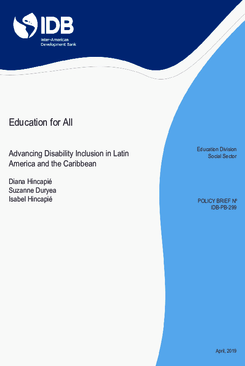Education for All: Advancing Disability Inclusion in Latin America and the Caribbean
Date
Apr 2019
This policy brief uses data from censuses and household surveys in the Latin America and the Caribbean (LAC) region to analyze the gaps in school attendance and completion rates between children and youth with and without disabilities. We find that children and youth with disabilities are less likely to attend school and to complete key levels of education, such as secondary school. Attendance gaps across disability status are larger for youth of secondary school age (12-17) than for children of primary school age (6-11) with youth ages 12-17 with disabilities 10 percentage points on average less likely to attend than youth without disabilities. While the available data do not lend themselves to intertemporal comparison, the results suggest that inclusion has not been realized across this small sample of countries, particularly with regard to those aged 12−17. We find that exclusion in secondary school was lowest in Chile where the gap in attendance across youth with and without disabilities for ages 12-17 was lower than 2 percentage points. While there is some data that suggests many schools do not have the appropriate infrastructure for students with physical disabilities, there is a lack of information regarding the accessibility for students with visual,auditory, cognitive and other disabilities. A shift to inclusive education requires political will and commitment conveyed with a strong and consistent message throughout the education system. Overcoming the main barriers to education inclusion can be accomplished through: (i) improving early identification of children with disabilities; (iii) strengthening data on school accessibility; (iii) implementing universal standards for accessibility and earmarking schools with higher needs with additional resources to support reasonable accommodation; (iv) training teachers and providing trained aides.




